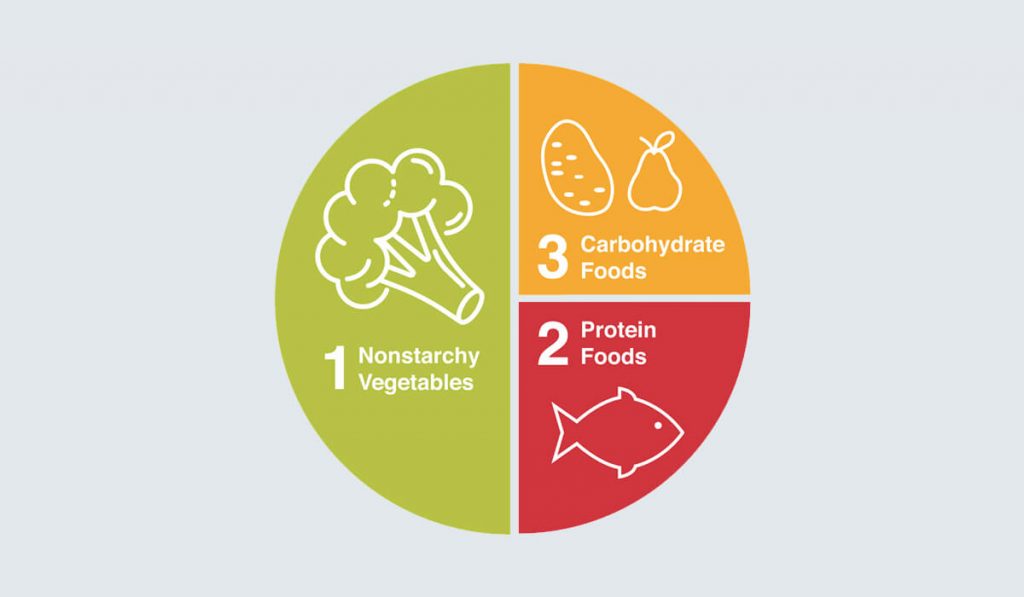
Move Over the Food Pyramid…Try the Diabetes Plate Method!🍽

Just in time for the holidays and those New Year’s resolutions, we share the benefits of using the ‘Plate Method’ to help you put your best “fork” forward and improve your healthy eating habits! Let’s dig in!
➡ What is the Plate Method?
MyPlate was the healthy eating guide published by the United States Department of Agriculture (USDA) in 2011, replacing the USDA food pyramid diagrams. It focuses on five different food groups: fruits, vegetables, grains, protein, and dairy. The MyPlate website has a wide range of information, including age-specific food tips and resources for all stages of life.
 The American Diabetes Association has also created a ‘plate method’ to help you manage your diet from a diabetes-specific perspective called the Diabetes Plate Method. The main differences between the two are that the Diabetes Plate Method does not include a separate section of the plate for fruits or dairy; these things are included in the carbohydrate section. (Foods that are higher in carbohydrates have the greatest effect on blood sugar, causing it to rise after a meal.)
The American Diabetes Association has also created a ‘plate method’ to help you manage your diet from a diabetes-specific perspective called the Diabetes Plate Method. The main differences between the two are that the Diabetes Plate Method does not include a separate section of the plate for fruits or dairy; these things are included in the carbohydrate section. (Foods that are higher in carbohydrates have the greatest effect on blood sugar, causing it to rise after a meal.)➡ Daily Food Group Targets
These are recommendations for daily amounts of each food group.
MyPlate(Using Cup/Ounce Measurements) |
Diabetes Plate Method(Using a 9 Inch Plate) |
Fruits – 2 cups1 cup counts as…
|
|
Vegetables – 2.5 cups1 cup counts as…
|
Non Starchy Vegetables – ½ your plateExamples:
|
Grains – 6 ounces1 ounce counts as…
|
Carbohydrates – ¼ plateExamples:
|
Protein – 5.5 ounces1 ounce counts as…
|
Protein – ¼ of your plateExamples:
|
Dairy – 3 cups1 cup counts as…
|

➡ Creating a Meal Plan
These are tips recommended by MyPlate to help you create a weekly meal plan.Use what you have!
- Plan meals using foods that you already have.
- Check in the freezer, refrigerator, pantry, and cabinets. Don’t forget to check expiration dates!
Write out your meals.
- Sometimes you can get halfway through the week and forget what your plan was. Make it easier on yourself by writing out your week’s meals ahead of time.
- Don’t forget to include snacks!
Think about your activities for the week.
- If you have a busier night sometime in the week, try to prep your meals and snacks ahead of it. This can make it easier for you to follow your meal plan.
Make a grocery list.
- Buying your groceries once a week can help save you time. Make sure to make your list before you head to the store.
Reuse your leftovers.
- Freeze your leftovers for later or make double the recipe so you can eat it multiple times throughout the week. This can help save you time and money.
👀 Resources
There are plenty of online resources that can help you follow your healthy eating habits!- Take the MyPlate quiz to determine what you know about healthy eating and help get you started in the right direction!
- Receive a personalized food plan based on age, sex, height, weight, and activity level with the MyPlate Plan.
- Diabetes Hub has information about reading food labels and diet swaps that you can easily make for a sustainable, healthy diet.
- MyPlate’s website has a recipe of the month as well as a large collection of different recipes you can try out! You can refine the collection by courses, nutrition-focused food group/nutrient, cooking equipment, cuisine, and total cost. The recipes list nutrition facts for one serving; you can save your recipes and create a “cookbook” online. The website also has cooking videos as well as other recipe resources.
- Another great resource for recipes is the Diabetes Food Hub, which is a collection of recipes from experts at the American Diabetes Association. The website allows you to save your recipes, plan your weekly meals, and create a grocery list!
Summary “Eating healthy” can often seem like a daunting task, but following the Plate Method can help you break it down into manageable components. Being proactive and creating a plan can help to save you time and money. Remember, improving your diet, along with exercise and medication management, can help to improve your diabetes!

Disclaimer: Any information provided is not intended as medical advice. Iowa Diabetes is not responsible for any information from third parties.





